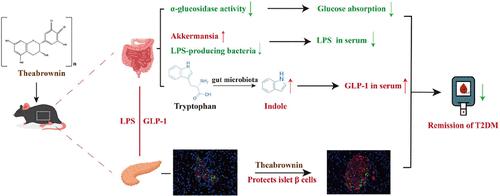茶啡肽通过调节LPS/GLP-1水平和恢复胰岛细胞减轻db/db小鼠2型糖尿病:来自肠-胰轴的证据
IF 6.2
1区 农林科学
Q1 AGRICULTURE, MULTIDISCIPLINARY
引用次数: 0
摘要
茶啡肽已被证明具有代谢调节作用,但在以前的研究中使用的剂量很难通过经常喝茶来达到。本研究在db/db 2型糖尿病(T2DM)小鼠模型中重新评估了其生理相关剂量的降糖作用,重点关注肠道微生物群和代谢途径。结果表明,褐蛋白通过抑制十二指肠α-葡萄糖苷酶延缓葡萄糖吸收。它还可以减少产生脂多糖(LPS)的细菌,增加嗜粘杆菌的丰度,降低血清脂多糖水平,减轻氧化应激引起的β细胞功能障碍。此外,褐肽促进色氨酸代谢的微生物吲哚途径,增强胰高血糖素样肽-1 (GLP-1)的分泌,有助于减轻β细胞功能障碍。综上所述,褐肽显示出作为T2DM治疗的膳食补充剂的潜力,主要是调节LPS/GLP-1水平和恢复胰岛功能。这些发现强调了发酵茶在葡萄糖代谢调节中的潜在作用。本文章由计算机程序翻译,如有差异,请以英文原文为准。

Theabrownin Alleviates Type 2 Diabetes Mellitus in db/db Mice via Modulating LPS/GLP-1 Levels and Restoring Islet Cells: Evidence from Gut–Pancreas Axis
Theabrownin has demonstrated metabolic-modulating effects, but the doses used in previous studies are difficult to achieve through regular tea consumption. This study reassesses its hypoglycemic effects at physiologically relevant doses in the db/db mouse model of type 2 diabetes mellitus (T2DM), with a focus on intestinal microbiota and metabolic pathways. The findings show that theabrownin delays glucose absorption by inhibiting α-glucosidase in the duodenum. It also reduces lipopolysaccharide (LPS)-producing bacteria, increases Akkermansia muciniphila abundance, lowers serum LPS levels, and alleviates β-cell dysfunction due to oxidative stress. Additionally, theabrownin promotes the microbial indole pathway of tryptophan metabolism, enhancing glucagon-like peptide-1 (GLP-1) secretion, which helps mitigate β-cell dysfunction. In conclusion, theabrownin shows potential as a dietary supplement for T2DM treatment, primarily regulating LPS/GLP-1 levels and restoring pancreatic islet function. These findings highlight the potential role of fermented tea in glucose metabolism regulation.
求助全文
通过发布文献求助,成功后即可免费获取论文全文。
去求助
来源期刊
CiteScore
9.90
自引率
8.20%
发文量
1375
审稿时长
2.3 months
期刊介绍:
The Journal of Agricultural and Food Chemistry publishes high-quality, cutting edge original research representing complete studies and research advances dealing with the chemistry and biochemistry of agriculture and food. The Journal also encourages papers with chemistry and/or biochemistry as a major component combined with biological/sensory/nutritional/toxicological evaluation related to agriculture and/or food.

 求助内容:
求助内容: 应助结果提醒方式:
应助结果提醒方式:


